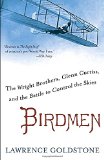Summary | Excerpt | Reviews | Beyond the Book | Readalikes | Genres & Themes | Author Bio
The Wright Brothers, Glenn Curtiss, and the Battle to Control the Skies

Critics' Opinion:
Readers' Opinion:
First Published:
May 2014, 448 pages
Paperback:
Apr 2015, 448 pages
 Book Reviewed by:
Book Reviewed by:
Poornima Apte
Buy This Book
The first, Edward Chalmers Huffaker, a Tennessean who went by E.C., was a forty-year- old slovenly, tobacco-chewing engineer who had submitted a paper in 1893, "The Value of Curved Surfaces in Flight," to the Congress on Aerial Navigation, an event sponsored by Octave Chanute, who then recommended him to Langley. The always fastidious Langley tried to overlook Huffaker's personal habits, and put him to work on devising the optimal airfoil configuration. The second new assistant came with a reputation for brilliance and would become the most controversial figure in the annals of early flight.
Augustus Moore Herring was also a southerner, born in Georgia in either 1865 or 1867, son of a cotton broker. The family relocated to New York when Herring was a boy. He attended Stevens Institute of Technology, where he later claimed either to have graduated or to have been denied graduation because his senior thesis on aeronautics was too sophisticated for the faculty to grasp. Both claims were false. He was dismissed from school for failing a number of courses and he never attempted to write on aeronautics. Unsubstantiated assertions or outright lies would follow Herring throughout his life.
Audacious and deceitful as he might have been, Herring did not lack either intelligence or talent. Shortly after he left Stevens, he built two Lilienthal-type gliders and showed a remarkable grasp of the German's design principles. He began a consulting engineering practice that failed, so he took a job, as had Chanute, as a chainman on the railroad. Herring wrote to Chanute in 1894 and asked for his help. When Chanute was unable to find Herring work, he hired the young man to develop a more sophisticated manned glider model based on the Lilienthal principles. Chanute by that time had decided that the path to controlled, motorized flight must proceed through the aerodynamics of gliders, opposite the approach that Langley had taken but in accordance with the one that the Wrights would employ six years hence.
Herring showed great promise, but before the manned glider project could really get started he came to Langley's attention through James Means. Langley offered the young man a position on the aerodrome team at a good deal higher salary than Chanute was paying him. Although Chanute later wrote to Means, "You did me a rather ill turn," he gave his grudging blessing to the move and Herring accepted Langley's offer. He was given a senior assistantship, assigned to improve the aerodrome's overall design.
Two men more likely to clash than Langley and Herring are hard to imagine. It took only five days before Herring wrote to Chanute complaining about the meticulous, rigid perfectionist from whom he had accepted a position. (He also took pains to mention that he was not alone in his dissatisfaction. Huffaker was described as "on the verge of nervous prostration.") One month later, Herring renewed his lament in another letter to Chanute. What irked Herring the most, it seemed, was that while the assistants did all the work, Langley took the credit—as long as things went well. When they did not, the assistants were assumed to be at fault. Herring endured for eighteen months, until November 1895, and then resigned. The only surprise was that he lasted so long. But during his tenure, Herring had made invaluable contributions to the design of Aerodrome 6, particularly in the wing configuration and tail assembly. Without his participation, Langley would have had no chance.
On May 12, 1896, Langley was finally ready. With Alexander Graham Bell standing on the banks of the Potomac with a camera, Aerodrome 6 was launched. Bell later gave an account of the "remarkable experiment" to the newspapers. "The aerodrome or 'flying machine' . . . resembled an enormous bird soaring in the air with extreme regularity in large curves, sweeping steadily upward in a spiral path, the spirals with a diameter of perhaps 100 yards, until it reached a height of 100 feet in the air at the end of a course of about half a mile." After the "steam gave out," Bell added, "to my further surprise, the whole, instead of tumbling down, settled as slowly and gracefully as it is possible for a bird to do, touched the water without any damage, and was picked out immediately and ready to be tried again."
Excerpted from Birdmen by Lawrence Goldstone. Copyright © 2014 by Lawrence Goldstone. Excerpted by permission of Ballantine Books. All rights reserved. No part of this excerpt may be reproduced or reprinted without permission in writing from the publisher.




Never read a book through merely because you have begun it
Click Here to find out who said this, as well as discovering other famous literary quotes!
Your guide toexceptional books
BookBrowse seeks out and recommends the best in contemporary fiction and nonfiction—books that not only engage and entertain but also deepen our understanding of ourselves and the world around us.